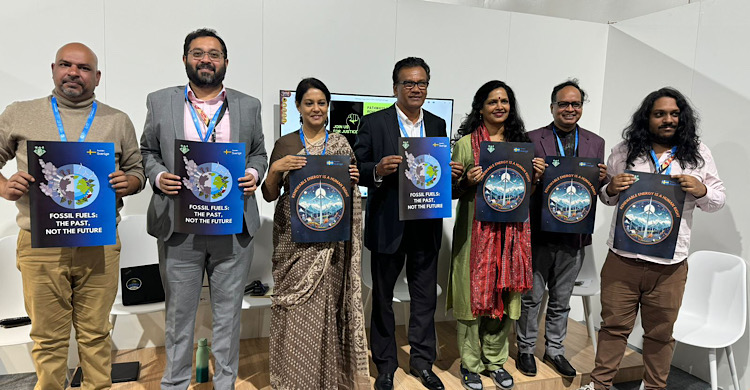South Asia, Including Bangladesh, Needs USD 625 Billion Over the Next Six Years to Triple Renewable Energy Capacity


Azerbaijan, Baku] South Asia, home to 1.93 billion people (27% of the global population), stands at a critical moment in its renewable energy transition. Despite its vast resources, the region’s average per capita electricity consumption is only 656 kWh, which is 74% less than the developing Asia average and 80% below the global average. To address these disparities and achieve climate goals, South Asia must significantly accelerate its RE transition. A discussion was organized on “Pathways to tripling renewable energy in South Asia” today in Baku, Azerbaijan by Shakti Foundation, Coastal Livelihood and Environmental Action Network (CLEAN) and Friends of the Earth.
South Asia has a total installed power capacity of 524.3 GW, with India leading at 446.2 GW, followed by Pakistan (41.9 GW), Bangladesh (28.1 GW), Sri Lanka (5 GW), and Nepal (3.1 GW). While most countries have achieved nearly universal electricity access, quality remains a pressing issue. Renewable energy constitutes only 9.9% of the region’s energy mix, with most electricity still generated from coal (67%) and fossil gas (6%). By 2030, South Asia aims to install 552.7 GW of renewable energy. However, achieving this goal requires an estimated USD 625 billion over the next six years. Shifting to distributed renewable energy systems could reduce these costs by up to 50% while empowering communities and reducing the burden on national grids.
Honorable Advisor of the Ministry of Environment, Forest and Climate Change, Advocate Syeda Rizwana Hasan mentioned “To increase the renewable energy target, we need the right political vision and effective economic modeling. Otherwise, we will continue making excuses, such as a shortage of land. For instance, 16,000 acres of land were allocated for developing export processing zones (EPZ), while only 10,000 acres would have sufficed for renewable energy needs.”
“The former government failed to keep up with market dynamics, relying heavily on import-driven energy rather than leveraging domestic resources. It neglected to explore natural opportunities for discovering more gas fields in Bangladesh, conducted no feasibility studies for exploration, and prioritized importing LNG and coal instead. However, under new leadership, there is a shift toward renewables. The government is reconsidering high tariffs on RE imports and inviting foreign entities to establish solar plants in Bangladesh. Air pollution, largely driven by power plants, is a significant environmental concern, making this the ideal time for Bangladesh to invest in renewables’ she added.
“SREDA has already noted that utilizing rooftops could fulfill up to 40% of the country’s renewable energy needs. Additionally, barren lands, such as those in tea estates, and underutilized government lands, can be harnessed for RE development, ensuring no shortage of resources. Our Chief Advisors are also politically committed to advancing renewable energy. “
“Bangladesh has started importing hydropower from Nepal and is exploring additional hydropower opportunities from Nepal and Bhutan through India. If we establish a regional transmission system, renewable energy from solar and wind can also be integrated efficiently.”
Hasan Mehedi from CLEAN, Bangladesh mentioned "South Asia must leverage its vast solar and wind resources through regional cooperation. A regional renewable energy grid could help countries share resources and achieve climate targets collectively."
Imran Ahmed of Shakti Foundation highlighted that "Women are central to future prosperity of Bangladesh. Empowering displaced women through entrepreneurial training has already added 360 MW of clean energy through 6 million solar home systems in Bangladesh. Community engagement will ensure ownership and sustainability."
Vidya Dinker from GrowthWatch, India, called for decentralized energy systems. She stated "India’s push for private-sector nuclear energy overlooks the potential of decentralized renewables to power rural communities. A transition from fossil fuels to renewables is critical for human rights and environmental justice."
Hemantha Withanage of Friends of the Earth Asia Pacific mentioned "Renewable energy projects must consider environmental impacts. For example, wind farms in bird migration routes could harm biodiversity. Sustainable planning is essential to balance development with conservation."
M. Zakir Hossain Khan from Change Initiative mentioned "South Asia has 600 million people without access to energy and receives only 1% of global climate finance, with 60% of it being debt. High-risk nations like Nepal, Bhutan, and Sri Lanka cannot bear such costs. The focus should shift to smaller projects of 50-200 MW and sub-regional grids instead of large-scale initiatives. Transparent, low-cost investments through public-private partnerships are essential. Carbon markets are risky, and new coal plants must stop per the Paris Agreement. Public finance must prioritize community-led systems to ensure resilience without relying solely on insurance."
In conclusion, to accelerate renewable energy adoption, South Asia must establish a clear financing roadmap combining grants, public-private partnerships, and investments. Governments should implement a fossil fuel moratorium while promoting distributed renewable systems, such as rooftop solar to empower communities. Strengthening regional cooperation through sub-regional grids and ensuring access to advanced technologies for rapid deployment are essential steps toward achieving these goals.
